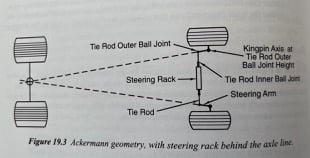Sale ends todayGet 30% off any course (excluding packages)
Ends in --- --- ---
Discussion and questions related to the course Motorsport Wheel Alignment Fundamentals
Currently building a "angle kit" for my 1974 Monte Carlo drift car. I'm about half way through the course but figured it wouldn't hurt to ask the question I'm looking an answer for. Everything I'm using is aftermarket so I have nothing to compare too.
The question is how do you measure positive, negative or no Ackerman?
Visually looking at the steering arm it appears to look negative ackerman but without knowing how to measure it I could be wrong
Ackerman geometry is when the a line drawn through the steering arms (as shown in the diagram attached) intersects at the center of the rear axle. If this intersection point if forward of the rear axle then this is positive Ackerman Geometry, and if it's behind then it's Anti-Ackerman (probably your "negative" term)

To follow up on that, it's possibly better illustrated by what you're intending because of the application you are using it in.
The ackermann principle is to have the line projected out from the rear axle, and through each of the front stub axles, meet at the same point.
This is so each wheel is tracking through (tangental) to the arc it is travelling through - with a normally driven car where the steering tyres are in the direction of the curve, with the inner steering tyre leading. This can be seen as "toe out".
However, with a 'drift' car it's rather more complex as the oversteer means the wheels are turned away from the centre of the curves the tyres are moving from, with the outer steering tyre leading - ie, the steering wheels follow arcs that require the tyres to "toe out".
What this means is, you hve a problem, because you have two opposite requirements, for 'understeer' and 'oversteer', and it may be further compromised by the geometry between the various steering components, initial static geometry settings, component deflections, and even bump steer in some cases.
I'd suggest avoiding overthinking at this point, and checking out what others are using - perhaps experimenting with different initial amounts of toe-in, and out, to get a feel of what works best for you - tyre wear isn't going to have the same concerns for you as for someone looking for 40k miles out of their tyres.
